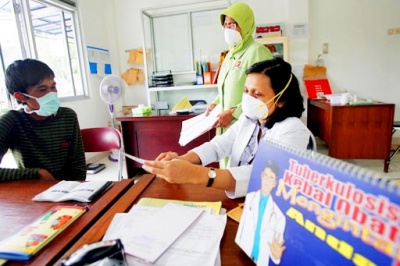
Patients suffering from tuberculosis (TB) must complete their treatment as unfinished medication could lead to the growth of drug-resistant bacteria, which could easily spread to others in the form of multi-drug resistant TB (MDR TB).
And while it may take years for others to develop drug-resistant TB, Aan Hariyadi, a 32 year-old computer programmer from Cengkareng, West Jakarta, contracted MDR TB after one month.
“I was quite fit and healthy until I got this pain in my chest and my health started to deteriorate,” he told The Jakarta Post recently.
He first took over-the-counter medicine for chest pains until doctors at a clinic in Cengkareng diagnosed him with TB. Aan received treatment for TB at a community health center for six months before being transferred to Persahabatan Hospital in Central Jakarta after showing no signs of improvement.
Drug-resistant strains of TB will likely become more prevalent in Indonesia, which now ranks ninth in the list of countries with the highest number of MDR TB cases. Data from the World Health Organization (WHO) says that Indonesia registered 6,100 cases of MDR TB in 2011.
The government said it faced challenges in dealing with the problem.
“So far we have only been able to treat 410 patients with MDR TB,” said Dyah Erti Mustikawati, director of tuberculosis at the Health Ministry’s directorate general for disease control and environmental health (P2PL).
She said people in urban areas are more susceptible to MDR TB.
Halving the prevalence of TB by 2015 is one of Indonesia’s Millennium Development Goals (MDGs).
Data from the Health Ministry shows that TB incidents declined to 189 per 100,000 people in 2010 from 343 per 100,000 people in 1990. Deaths from TB have also declined by 71 percent from 92 per 100,000 people to 27 per 100,000 people in 2010.
Tjandra Yoga Aditama, the ministry’s director general for disease control and environmental health (P2PL) said that despite the rapid decline of TB incidences, the illness remained a serious health problem in the country.
“Tough challenges persist, including MDR TB, which continues to soar,” he said.
Data from the ministry also shows that new TB infections reached 450,000 cases per year, with the death rate nearing 64,000 people per year or 175 deaths per day. Most of the cases affected people from productive age groups, between 15 and 55 years old.
To avoid the development of drug-resistant strains, the government is currently implementing the Directly Observed Treatment Shortcourse (DOTS) and Programmatic Management of Drug Resistant TB (PMDT) programs, in which patients undergo medical treatment, including the consumption of second-line TB drugs, only under close assistance and monitoring from healthcare workers.
Although MDR TB is curable, it is much harder to treat as it includes a regimen of second-line TB drugs, which are more expensive and impose an additional burden on healthcare costs.
Treatment plans for MDR TB are also longer, ranging between 18 and 24 months. The lengthy treatment and the side effects of the medication might cause some patients to fail to complete the necessary course of medications.
Depression is one of side effects of MDR TB drugs. Others could include gastro-intestinal problems, headaches, vertigo, insomnia, hearing and emotional disorders, and even suicidal tendencies.
Erlina Burhan, a pulmonologist from Persahabatan Hospital, said psychiatric support played a key role in MDR TB treatment, as most patients suffered from depression.
“You can imagine how hard such a drug regimen like this must be to take. They must inject drugs everyday for six months, and take oral medicines every day for 24 months. The drugs are more toxic, causing severe side effects,” she said.